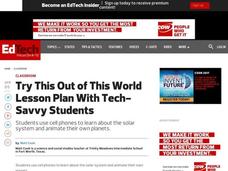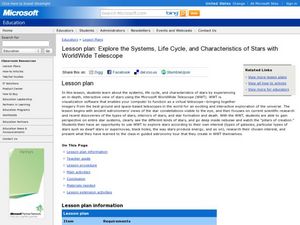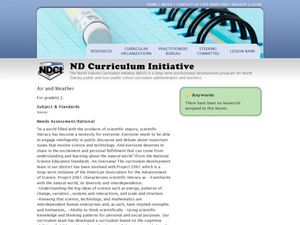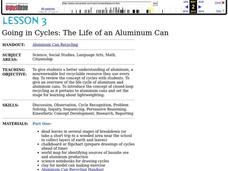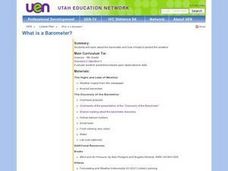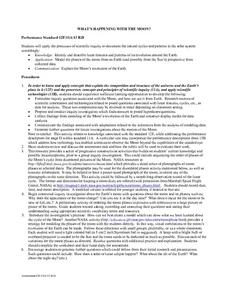Curated OER
Hurricanes and Tornadoes (Grade 4-8)
Students investigate the concepts of hurricanes and violent weather conditions. For this violent weather lesson, students access an Internet site and watch a video about how air masses behave, how a tornado forms, how hurricanes form,...
Curated OER
Out of This World
Fifth graders animate their own planets. In this solar system lesson, 5th graders use smartphones and the software, GoKnow Sketchy, to create images for presentations on their created planets that appear to be animated when played...
Curated OER
The Tides-Ups and Downs
Students investigate tidal patters and the forces that cause the tides. In this tidal lesson plan, students explore and research the tides and complete 43 questions about the causes of the tides, how they are monitored and measured and...
Curated OER
Water: Our Most Important Beverage
Third graders complete a KWL chart on what they already know about water and what they want to know. As a class, they participate in an activity in which they discover the amount of drinkable water on Earth and are introduced to the...
Curated OER
Explore the Characteristics of Stars with Microsoft WorldWide Telescope
Students explore the characteristics of stars. In this space science activity, students use the Microsoft WorldWide Telescope program to identify the properties of stars and identify the stars in the galaxy.
Curated OER
Water Reflections:
Students analyze data from monitoring activities . They summarize, post, and present the data from activities. They tell others in the community what they've learned about local water quality.
Curated OER
Water
Students learn about the history of Indiana's water and understand how easily pollution can contaminate the water supply. They also learn how little fresh water we have and how important it is to protect it.
Curated OER
Air and Weather
Second graders study Earth's materials. In this air and weather lesson, 2nd graders note changes in the weather and examine tools that help us study the weather. Students analyze how changes in the environment make changes in the...
Curated OER
Trends Forecasting
Students practice trends forecasting to predict the weather. In this forecasting lesson plan, students learn how meteorologists predict the weather by looking at weather trends. They then predict their own forecast, analyze the results,...
Curated OER
Measuring Cloud Coverage
Students explore Earth science by completing weather symbol worksheets. For this cloud identification lesson, students identify the different types of clouds in the sky and how they are formed. Students complete a cloud measurement...
Curated OER
What Makes a Home "Energy Efficient"?
Learners research and report the costs and benefits of making their own homes more energy efficient. In this energy conservation lesson, students explore energy efficient technologies and design over several days. They complete a home...
Curated OER
Kyoto Protocol
In this environment activity, students read an article about setting up the Kyoto Protocol, an international treaty. They identify the meaning of human environment and what the Earth's greenhouse effect is. Students also explain the...
Curated OER
Swimming With the Crabs!
In this environmental science instructional activity, students complete a graphic organizer (Frayer model) on blue crabs. They write an article using the given facts.
Curated OER
WaterWeb
In this water instructional activity, students answer 10 multiple-choice questions about the water cycle. Students also describe how they think their community is involved in sustaining water resources and write a pretend radio...
Curated OER
Terrariums: A Look at the Living and Nonliving World
Third graders examine life in a terrarium and relate it to life in a larger environment. In this terrarium lesson, 3rd graders examine how living and non-living things work together by examining the changes in a terrarium. They make...
Curated OER
Going in Cycles: The Life of an Aluminum Can
Students investigate the manufacture of aluminum cans and consider the energy and resources saved when the cans are made from recycled material. They explore the concept of closed-loop recycling using charts, worksheets and discussion.
Project SMART
Rocks and Minerals: Touch the Earth
Students complete a unit of lessons on rocks and minerals. They conduct research, write e-mail questions to geologists, write daily journal entries, label maps demonstrating types of rocks/minerals found, and create a web page that...
Curated OER
Science: What Is a Barometer?
Fourth graders discover how barometers help to predict the weather. Using newspapers, they examine the weather forecast and determine the meaning of high and low as they pertain to pressure. After making cluster diagrams, 4th graders...
Curated OER
Recycled Water?
Young scholars participate in a hands-on activity to investigate how water is recycled in a small environment, and determine how water is cycled on earth.
Curated OER
Investigating Earth's Materials
First graders compare and contrast water from different sources. After collecting water from various sources, 1st graders create a list of observable properties of the water. Students then pour the water into a filter and observe the...
Curated OER
The Story of Rocks
In this science worksheet, students learn to classify rocks as igneous, sedimentary or metamorphic. Students learn what a mineral is and the stages of the rock cycle. Students experiment with samples of 7 minerals and record data on...
Curated OER
Rockets on a Shoestring Budget
Students, operating under simulated budget constraints, build pop-rockets and launch them. Working in pairs, they complete budget worksheets and use their "Blast Off Bucks" to pay for the construction. They then redesign their rockets...
Curated OER
What's Happening With the Moon?
Students review the process of scientific inquiry. Using this information, they identify the patterns and cycles of the moon as it revolves around the Earth. In groups, they model the phases of the moon from the Earth and Sun's...
Curated OER
Journal of the Stars
Students receive balloons representing the "Life Cycle of the Stars." As the attached script is read, students follow the directions for the color of balloon they are given. Students chart the results for their star. They plot data from...

